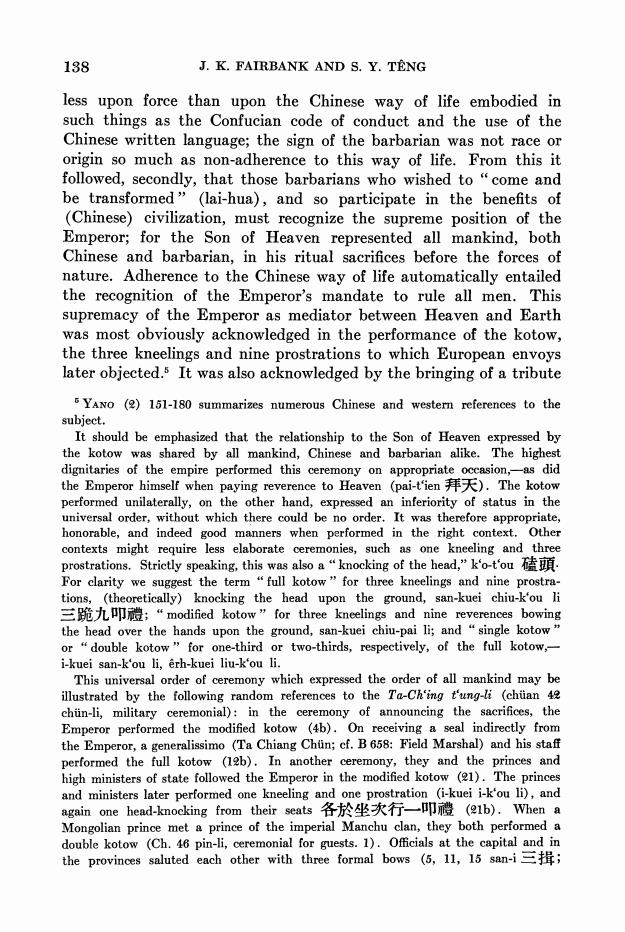正在加载图片...

138 J.K.FAIRBANK AND S.Y.TENG less upon force than upon the Chinese way of life embodied in such things as the Confucian code of conduct and the use of the Chinese written language;the sign of the barbarian was not race or origin so much as non-adherence to this way of life.From this it followed,secondly,that those barbarians who wished to "come and be transformed"(lai-hua),and so participate in the benefits of (Chinese)civilization,must recognize the supreme position of the Emperor;for the Son of Heaven represented all mankind,both Chinese and barbarian,in his ritual sacrifices before the forces of nature. Adherence to the Chinese way of life automatically entailed the recognition of the Emperor's mandate to rule all men.This supremacy of the Emperor as mediator between Heaven and Earth was most obviously acknowledged in the performance of the kotow, the three kneelings and nine prostrations to which European envoys later objected.5 It was also acknowledged by the bringing of a tribute s YANo (2)151-180 summarizes numerous Chinese and western references to the subject. It should be emphasized that the relationship to the Son of Heaven expressed by the kotow was shared by all mankind,Chinese and barbarian alike.The highest dignitaries of the empire performed this ceremony on appropriate oceasion,-as did the Emperor himself when paying reverence to Heaven (pai-t'ien).The kotow performed unilaterally,on the other hand,expressed an inferiority of status in the universal order,without which there could be no order.It was therefore appropriate, honorable,and indeed good manners when performed in the right context.Other contexts might require less elaborate ceremonies,such as one kneeling and three prostrations,.Strictly speaking,this was also a“knocking of the head,”ko-t'ou磕頭. For clarity we suggest the term "full kotow"for three kneelings and nine prostra- tions,(theoretically)knocking the head upon the ground,san-kuei chiu-k'ou li 三跪九p體;“modified kotow”for three kneelings and nine reverences bowing the head over the hands upon the ground,san-kuei chiu-pai li;and "single kotow" or "double kotow"for one-third or two-thirds,respectively,of the full kotow, i-kuei san-k'ou li,erh-kuei liu-k'ou li. This universal order of ceremony which expressed the order of all mankind may be illustrated by the following random references to the Ta-Ch'ing t'ung-li (chiian4 chun-li,military ceremonial):in the ceremony of announcing the sacrifices,the Emperor performed the modified kotow (4b).On receiving a seal indirectly from the Emperor,a generalissimo (Ta Chiang Chiin;cf.B 658:Field Marshal)and his staff performed the full kotow (12b).In another ceremony,they and the princes and high ministers of state followed the Emperor in the modified kotow (21).The princes and ministers later performed one kneeling and one prostration (i-kuei i-k'ou li),and again one head-knocking from their seats各於坐求行一叩醴(eIb).When a Mongolian prince met a prince of the imperial Manchu clan,they both performed a double kotow (Ch.46 pin-li,ceremonial for guests.1).Officials at the capital and in the provinces saluted each other with three formal bows (5,11,15 san-i;138 J. K. FAIRBANK AND S. Y. TtNG less upon force than upon the Chinese way of life embodied in such things as the Confucian code of conduct and the use of the Chinese written language; the sign of the barbarian was not race or origin so much as non-adherence to this way of life. From this it followed, secondly, that those barbarians who wished to "come and be transformed" (lai-hua), and so participate in the benefits of (Chinese) civilization, must recognize the supreme position of the Emperor; for the Son of Heaven represented all mankind, both Chinese and barbarian, in his ritual sacrifices before the forces of nature. Adherence to the Chinese way of life automatically entailed the recognition of the Emperor's mandate to rule all men. This supremacy of the Emperor as mediator between Heaven and Earth was most obviously acknowledged in the performance of the kotow, the three kneelings and nine prostrations to which European envoys later objected.5 It was also acknowledged by the bringing of a tribute 5YANO (2) 151-180 summarizes numerous Chinese and western references to the subject. It should be emphasized that the relationship to the Son of Heaven expressed by the kotow was shared by all mankind, Chinese and barbarian alike. The highest dignitaries of the empire performed this ceremony on appropriate occasion,-as did the Emperor himself when paying reverence to Heaven (pai-t'ien ) The kotow performed unilaterally, on the other hand, expressed an inferiority of status in the universal order, without which there could be no order. It was therefore appropriate, honorable, and indeed good manners when performed in the right context. Other contexts might require less elaborate ceremonies, such as one kneeling and three prostrations. Strictly speaking, this was also a " knocking of the head," k'o-t'ou ;fflFor clarity we suggest the term " full kotow " for three kneelings and nine prostrations, (theoretically) knocking the head upon the ground, san-kuei chiu-k'ou 1i -WE JL lDjoiP; " modified kotow " for three kneelings and nine reverences bowing the head over the hands upon the ground, san-kuei chiu-pai li; and " single kotow" or " double kotow " for one-third or two-thirds, respectively, of the full kotow,- i-kuei san-k'ou li, erh-kuei liu-k'ou li. This universal order of ceremony which expressed the order of all mankind may be illustrated by the following random references to the Ta-Ch'ing t'ung-li (chilan 42 chfin-li, military ceremonial): in the ceremony of announcing the sacrifices, the Emperor performed the modified kotow (4b). On receiving a seal indirectly from the Emperor, a generalissimo (Ta Chiang Chiin; cf. B 658: Field Marshal) and his staff performed the full kotow (12b). In another ceremony, they and the princes and high ministers of state followed the Emperor in the modified kotow (21). The princes and ministers later performed one kneeling and one prostration (i-kuei i-k'ou li), and again one head-knocking from their seats ?kPfiifPji k (21b). When a Mongolian prince met a prince of the imperial Manchu clan, they both performed a double kotow (Ch. 46 pin-li, ceremonial for guests. 1). Officials at the capital and in the provinces saluted each other with three formal bows (5, 11, 15 san-i 4 4$;